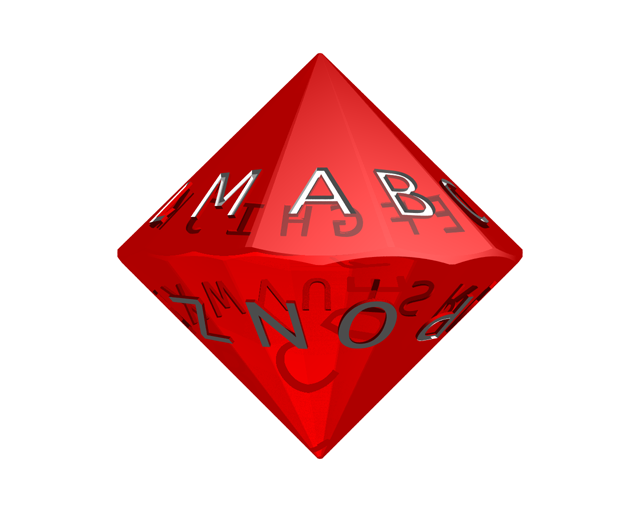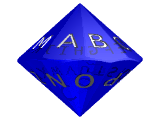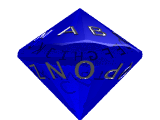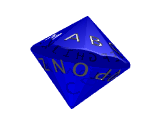[2008-08-04] Alphabet dice

Some years ago I became preoccupied with developing a robust yet accessible cryptosystem for use by nonprofessionals. The idea was to produce unbreakable crypto that anyone could use for short messages, even those who knew absolutely nothing about cryptography, without having to trust complex tools of another's manufacture. A modern computer is a fiendishly complicated device, and the litany of maximum paranoia is "do not trust what you do not understand." Since so few of us understand computers and electronics well enough to know with absolute certainty whether our data is truly secure, I decided that the enciphering system should be entirely mechanical and avoid digital storage or manipulation of plaintext altogether.
Those who are familiar with cryptography need no introduction to the concept of a one-time pad. Basically, the plaintext is encoded against a single use, completely random keystring, identical copies of which are held by the sender and the receiver. Used as intended, with no part of the key ever used more than once, a one-time pad produces ciphertext which is absolutely unbreakable. The concept is simple and elegant. The difficulty involves generating the keystring, which must be as long as all of the messages you ever intend to send or receive with it put together. To live up to the one-time pad's potential of perfect secrecy, the keystring must be 1) kept completely secure and 2) generated in a truly random fashion. Besides the security problem computers pose for the paranoid, mentioned above, the difficulty of generating truly random numbers using a computer is well documented. Mechanical generation of the keystring can solve both problems.
Dice, for instance, are a cheap and expedient mechanical means for generating near-perfect randomness, and the idea was that keytext would be generated by manually transcribing, in a secure environment, the results of a series of dice rolls onto the pages of a self-duplicating notebook of the type commonly used by scientists. The original and carbon-copied pages would then be separated and sealed in two envelopes, one of which would be retained by the "sender," and the second of which would be hand-delivered to the "receiver." In point of fact "sender" and "receiver" are arbitrary designations; communication using the system can be bidirectional. Now, so long as neither copy of the pad falls into the wrong hands, text encoded on the pad can be securely transmitted in the open, via unsecure channels such as e-mail or radio broadcast.
Obviously, this system strongly favors security over convenience. Suffice to say that manually generating many pages of keytext is a tedious job. To speed the process, multiple dice would be used, and the traditional practice of presenting ciphertext in five-letter groups suggests five as a convenient number to be rolled concurrently, with each die generating a single random letter. To save the effort of chasing rolled dice, a clear dice dome, cube, or popper would keep the dice corralled.
So far, so good. The problem emerged when I went to locate "alphabet dice" for this process, and discovered that there are no commercially-available dice with a one-to-one mapping of sides to English letters. There are, certainly, alphabet dice manufactured for educational purposes, but these either have unequal distributions of letters or "null" spaces which do not correspond to any letter. The first alternative causes the resulting keystring to deviate from pure randomness, and the second causes considerable additional inconvenience for the paranoid maniac stuck manually transcribing dice rolls into a notebook; he does not want to have to stop and re-roll any nulls that may appear.
What I wanted, but could not find, was a die with 26 faces corresponding to the 26 letters of the English alphabet, giving an equivalent chance of producing any letter. On first consideration, it is easy to see why there are no such dice: There are, after all, no 26-sided convex regular polyhedra, and the most familiar dice forms (4-sided, 6-sided, 8-sided, 12-sided, and 20-sided) all correspond to these "Platonic" solids. There are, however, other polyhedra that make fair dice. This, for instance, is how 10-sided dice are produced in spite of there being no 10-sided Platonic solid.
Shown here is my design for a 26-sided die for generating random English letters. It borrows from the principle of the 10-sided die, which consists of two "pentagonal cones" joined at their bases, which form the equator of the die. Each cone carries 5 of the 10 digits, and the two cones are rotated with respect to one another by 36 degrees so that when one side is flat on the rolling surface, the opposing "up" face will be parallel to it. Without this rotation, the resting die presents a vertical edge, rather than a face, and thus gives no clear value. This half rotation of one cone with respect to the other is necessary for any such die having an odd number of faces on each cone.
My die works in exactly the same way, except instead of pentagonal cones to each side of the equator my design employs triskadecagonal (13-gonal) cones. One half of the alphabet is arranged on the faces of one cone, and the other half on the other. The two cones are rotated by 13.846 degrees with respect to each other, again, so that the resting die presents an upper face parallel to the rolling surface.



last modified 2008-08-04